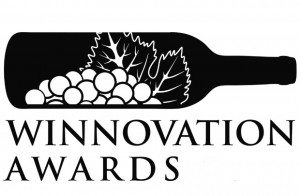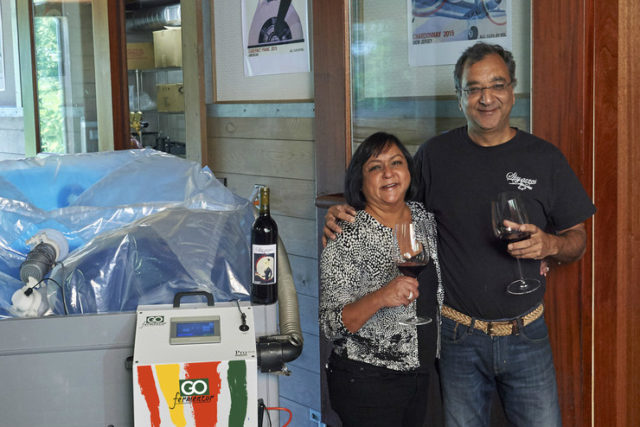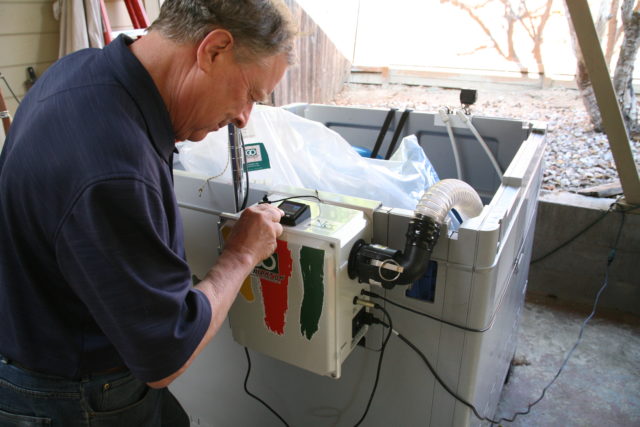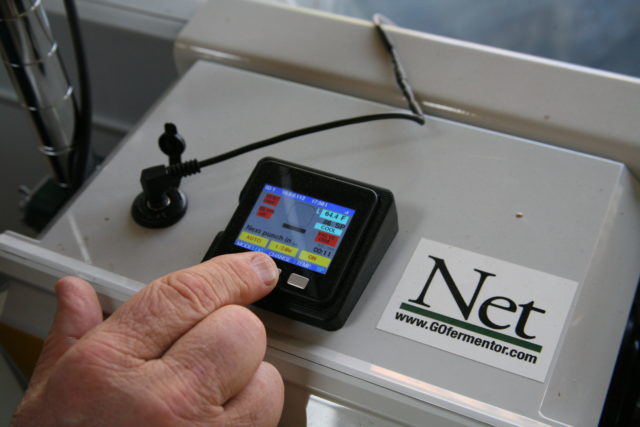By Elizabeth Hans McCrone
GOfermentor, a 2019 WINnovation Award winner
 When Vijay Singh wanted to build a winery in Bedminster, NJ six years ago, his wife Meera, a WSET Level 3 sommelier, was put off by the prospect. The labor-intensive process of small-scale winemaking requiring midnight punch downs and intensive barrel and tank-cleaning regimes was not her idea of fun for two people who were supposed to be “retired.”
When Vijay Singh wanted to build a winery in Bedminster, NJ six years ago, his wife Meera, a WSET Level 3 sommelier, was put off by the prospect. The labor-intensive process of small-scale winemaking requiring midnight punch downs and intensive barrel and tank-cleaning regimes was not her idea of fun for two people who were supposed to be “retired.”
Her reluctance, and the refusal of a permit from the zoning department official due to potential wastewater concerns, got Vijay to thinking about his previous experience in the pharmaceutical industry.

In 1999, Vijay had invented a machine that manufactured pharmaceuticals in single-use bags, eliminating problems with sterility and cleaning.
Vijay reasoned that the success of that endeavor and its basic principles could be applied to winemaking as well, so he got to work.
In 2017, after several years of trials that took place in the US, Italy, Australia and Spain, Vijay and Meera officially launched the GOFermentor as a commercial product. They also got the long coveted permit from the zoning department and now operate the only winery in Somerset County, NJ.
As many groundbreaking technologies, the GOfermentor concept appears simple, but required very complex mechanisms and custom plastic liners to become practical.
At harvest, grapes are placed in a plastic bag containing two compartments. Once yeast and nutrients have been added, the GOFermentor is turned on, the bag is activated and air fills the second chamber, pressing the grapes every two to three hours for about eight to ten days to “punch” the must until the sugar is gone.
The pressure and motion of the inflating air bladder disperses the cap during fermentation, keeping it moist. When the process is complete, the machine uses the air chamber to press out the wine from the pomace, which remains in the bag and can then be used for mulch or fertilizer. This feature eliminates the need for an expensive press that must be cleaned before and after use.
There is no exposure to air during fermentation and no water required for clean up once fermentation is accomplished. The bag itself is disposed of in a landfill, where it biodegrades. For the next fermentation, an entirely new bag is used and the process begins again.
According to Vijay Singh, the commercial GOfermentor can handle up to one ton of grapes in one run and produce about 150 gallons or about 700 bottles of wine.
“Our wine contains no sulfites because the process happens in closed bag; and there is no air to oxidize so preservatives such as sulfite are unnecessary,” Singh confirms. “And one of the best things – our system doesn’t require infrastructure. It takes up about a 4×4 foot space on the floor. All you need is a household 110 volt receptacle”
As a testament to the quality of wine the GOfermentor produces, Meera and Vijay have won more than 50 prestigious wine awards, including Best in Class at the 2019 San Francisco Chronicle wine competition for their Sky Acres Winery 2017 Black River Red.

“I think this thing is really wonderful,” comments Clark Smith, owner of WineSmith Wines and Consulting and a self-described “collector of game changing technologies.”
“The most important aspect of the GOfermentor is the wine quality.” Smith testifies. “All of their wines have good extraction and supple, round tannins. Here’s Vijay and Meera, with limited experience and they bag a medal from the San Francisco Wine Competition. I figure, why don’t we just do it their way?”
Smith is in a position to appreciate game changing technology.
He is a leading authority on wine structure enhancement and holds a patent for reverse osmosis methods for alcohol removal and volatile acidity correction. He also developed a popular class at UC Davis on The Fundamentals of Wine Chemistry, which has been attended by more than 4,000 students since 1984 (Wikipedia, 2019).
After learning about the Singh’s GOfermentor invention – and tasting the results – Smith purchased three of the units and began experimenting with the idea that quality winemaking can actually be accomplished by setting some controls, pushing a button and walking away.
“It eliminates the labor of punch down, not to mention cross contamination problems in cellar environments,” Smith reports. “This machine pays for itself in one season.”

Smith notes that a colleague of his from France recently purchased two of the GOfermentor units and has been impressed with their labor-saving features.
“He travels a lot as a consultant. Now he can just crush his grapes, go away for two to three weeks, come back, throw the bag away and that’s it.”
Throwing the bag away may be one aspect of the GOfermentor process that some winemakers find objectionable, given the increasing concerns about environmental impact.
Vijay Singh is both practical and philosophical about the question.
“Without plastic, life is not possible,” Vijay opines. “If you go to the grocery, chicken is in plastic. Our society requires it. With conventional (winemaking) methods, how much water is wasted, how much is polluted with detergent? Everything is a trade off.”
Vijay notes that the bags used in the GOfermentor are BPA-free/medical grade meeting FDA CfR177 for food contact.
“Our bags don’t contain plasticizers. They crumble in landfill quickly, they biodegrade,” he asserts. “One bag is used per ton of grapes. The average winery uses three one-tons bags per unit per year … with our system there is no contamination. There needs to be a balance with things.”
For his part, Smith says that the GOfermentor has “earned my unequivocal recommendation.”
He plans to use them to process eight tons of grapes this year and has partnered with Vijay Singh on 12-university collaborative study throughout the U.S. for the 2019 vintage that compares the GOfermentor method with grapes processed more traditionally, in a macro bin.
Vijay will present the preliminary results of the study at the WIN Expo on December 5, 2019 in Santa Rosa, CA. In January, the resulting wines will be sent to Spain for analytical and sensory evaluation.
“I’m going to make everything I do from now on in a GOfermentor,” Smith declares. “It’s neat to be in an industry for 48 years and then have this ah ha moment, realizing you’ve been doing this wrong all along.”
To learn more about GOfermentor’s WINnovation Award winning technology, visit them at the North Coast Wine Industry Expo and Conference December 5 in Santa Rosa, where they will be exhibiting at booth 604 and 703.

















